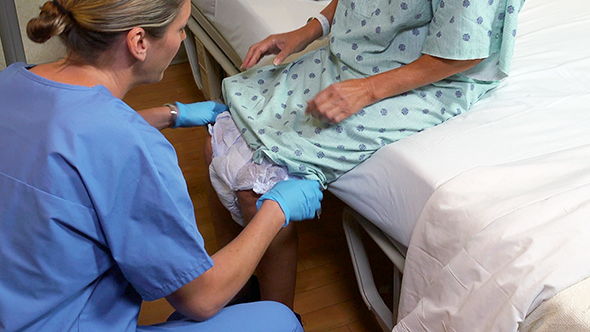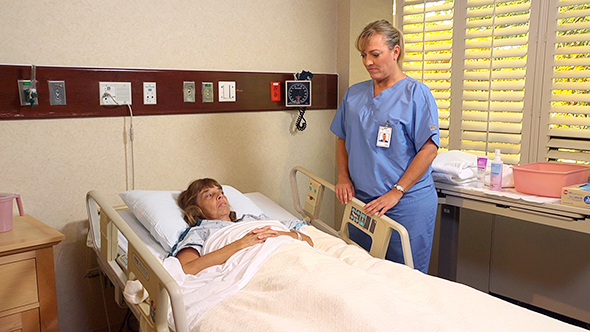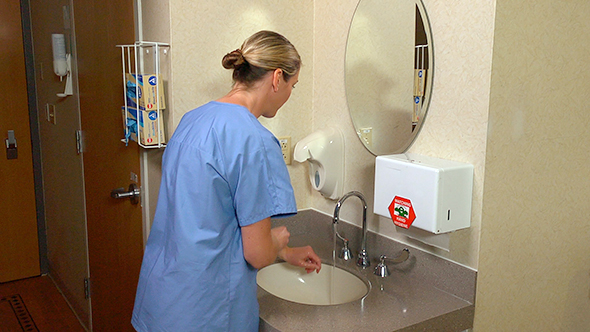Elimination Assistance
Select a Skill:
- » Helping the Person to the Commode
- » Applying Incontinence Products
- » Giving the Urinal
- » Giving the Bedpan
- » Applying a Condom Catheter
- » Giving Catheter Care
- » Emptying a Urinary Drainage Bag
- » Changing a Leg Bag to a Drainage Bag
- » Giving an Enema
- » Changing an Ostomy Pouch
Take the Review Test:

Purpose

- Urinary incontinence is the involuntary loss or leakage of urine. It may be temporary or permanent. Various types exist. Some causes of incontinence can be reversed. Others cannot. If incontinence is a new problem, tell the nurse at once.
- Incontinence is embarrassing. Garments are wet and odors develop. The person is uncomfortable. Skin irritation, infection, pressure ulcers, and falling are risks. Pride, dignity, and self-esteem are affected. Social isolation, loss of independence, and depression are common. Quality of life suffers.
- Good skin care and dry garments and linens are essential.
- Incontinence products help keep the person dry. They usually have two layers and a waterproof back. Fluid passes through the first layer. It is absorbed by the lower layer.
- Common incontinence products include a complete incontinence brief, pad and undergarment, pull-on (pull-up) underwear, and belted undergarment. The nurse helps the person select products to meet his or her needs.
Equipment
Roll cursor over items to see labels. For the purposes of clearly depicting the equipment, a barrier is not shown in this photo. When providing care, a barrier should always be placed on the surface before placing the equipment.

Bath blanket
Wash basin
Waterproof pad
Standard or bariatric-size incontinence product as directed by the nurse
Facility-approved barrier cream as directed by the nurse
Facility-approved cleanser
Non-skid footwear if the person will stand
Trash bag
Paper towels
Items for perineal care
Bath thermometer
Gloves
Delegation
- Follow delegation guidelines. Before applying incontinence products, obtain this information from the nurse and care plan:
- What product to use
- What size to use
- If you need to apply a barrier cream and, if yes, what cream to use
- What observations to report and record
- When to report observations
- What patient or resident concerns to report at once
Preparation

- Observe quality-of-life measures.
- Review the information under Delegation and Safety and Comfort.
- Practice hand hygiene.
- Collect the equipment.
- Cover the over-bed table with paper towels. Arrange items on top of them.
- Identify the person. Check the ID bracelet against the assignment sheet. Also call the person by name.
- Provide for privacy.
- Fill the wash basin. The water temperature is about 105˚F (40.5˚C). Measure the water temperature according to agency policy. Ask the person to check the water temperature. Adjust water temperature as needed.
- Raise the bed for body mechanics. Bed rails are up if used. (Omit this step if the person will stand.)
Safety

- To safely apply an incontinence product, follow the manufacturer’s instructions.
- To help prevent leakage and skin problems, follow these guidelines:
- Use the correct size incontinence product.
- Note the product’s front and back, and place its center in the perineal area.
- Position the man’s penis downward.
- Check for proper placement. It should be in the creases in the groin area.
- Note the amount of urine and how often you change the product.
- Do not let the plastic backing touch the person’s skin.
- Provide perineal care after each incontinent episode.
- Do not use the product as a turning or lift sheet.
- To avoid tearing, attach the tape tabs correctly.
- If the person will stand for the procedure, follow these guidelines:
- Make sure the bed is in the lowest position. Lock the wheels.
- Have the person wear non-skid footwear.
- Make sure the person has something to hold on to for balance and stability.
- Urine may contain microbes and blood. Follow Standard Precautions and the Bloodborne Pathogen Standard.
Comfort
- For the person’s comfort, always use the correct size product. If it is too large, urine can leak. If it is too small, the product will cause discomfort from being too tight.
Procedure Video
Audio Description: OFFFollow-up Care

- Provide for comfort.
- Place the call light within reach.
- Lower the bed to its lowest position. Raise or lower bed rails. Follow the care plan.
- Unscreen the person.
- Practice hand hygiene. Put on clean gloves.
- Estimate the amount of urine in the older product. Observe for urine color and blood.
- Clean, rinse, dry, and return the wash basin and other equipment. Return items to their proper place.
- Remove and discard gloves. Practice hand hygiene.
- Complete a safety check of the room.
Reporting/Recording
- Report and record your observations, including:
- Complaints of pain, burning, irritation, or the need to void
- Signs and symptoms of skin breakdown: redness, irritation, blisters, and complaints of pain, burning, tingling, or itching
- The amount of urine—small, moderate, or large
- Urine color or blood in urine
- Leakage or a poor product fit
Review Questions
Select the best answer.
1. What is an essential part of care for all people with incontinence?
 Restricted fluid intake
Restricted fluid intake Dry garments and linens
Dry garments and linens Use of a one-size-fits-all product
Use of a one-size-fits-all product Use of a complete incontinence brief
Use of a complete incontinence brief
Select the best answer.
2. When applying an incontinence product, what part should you place in the person’s perineal area?
Select the best answer.
3. When removing an incontinence product, how should you proceed?
 Remove it from front to back
Remove it from front to back Remove it from back to front
Remove it from back to front Remove it and fold it in half lengthwise
Remove it and fold it in half lengthwise Remove it from the center, holding it at the edges
Remove it from the center, holding it at the edges
Select the best answer.
4. When applying an incontinence brief, how should you position a man’s penis?
Select the best answer.
5. For a person with urinary incontinence, which observation may be a sign or symptom of skin breakdown?
You have completed the Review Questions for this skill. To take the Review again select the Start Over button. To proceed to another skill select from the dropdown menu. Select the Home or Back button to proceed to the next section.

